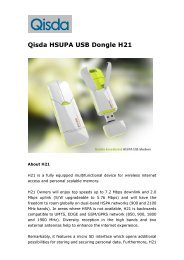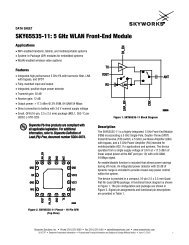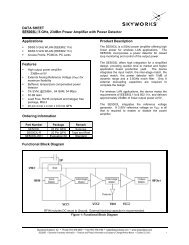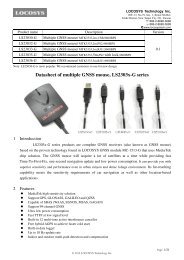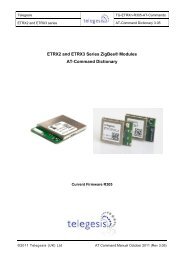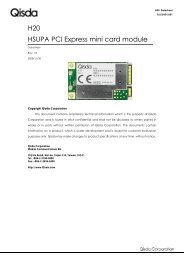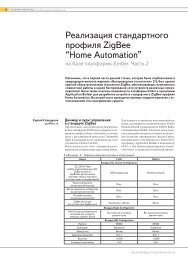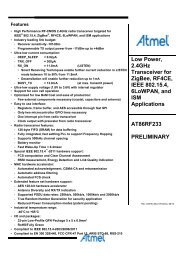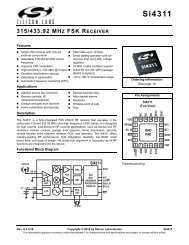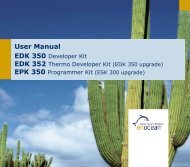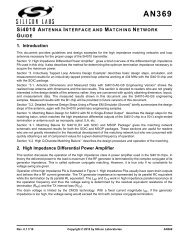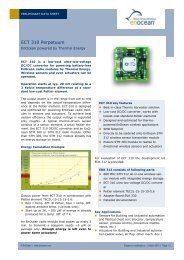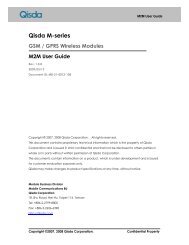AT Command Reference Guide for EDGE Wireless ... - wless.ru
AT Command Reference Guide for EDGE Wireless ... - wless.ru
AT Command Reference Guide for EDGE Wireless ... - wless.ru
You also want an ePaper? Increase the reach of your titles
YUMPU automatically turns print PDFs into web optimized ePapers that Google loves.
Chapter 4 – Serial Interface Control <strong>Command</strong>s<br />
4.10 <strong>AT</strong>+CMUX Enter Multiplex Mode<br />
Description: All in<strong>for</strong>mation provided in this section applies to the ASC0 interface only.<br />
Multiplex mode according to the ETSI TS 101 669 and GSM 07.10 enables one physical serial<br />
asynchronous interface to be partitioned into three virtual channels. This allows you to take<br />
advantage of up to 3 simultaneous sessions <strong>ru</strong>nning on the serial interface. For example, you<br />
can send or receive data or make a call on the first channel, while the other two channels are<br />
free to control the module with <strong>AT</strong> commands.<br />
The Multi-Tech wireless modem module incorporates an internal multiplexer and thus integrates<br />
all the functions needed to implement full-featured multiplex solutions. For the application on top,<br />
customers have the flexibility to create their own multiplex programs con<strong>for</strong>ming to the<br />
multiplexer protocol. To help system integrators save the time and expense of designing<br />
multiplexer applications, contact Multi-Tech about a ready-to-use multiplex driver <strong>for</strong> Windows<br />
2000 and Windows XP. Another approach is to develop customized solutions based on the<br />
sources of the WinMux2k driver.<br />
The WinMUX2k driver and its source files can be supplied on request. Please contact your local<br />
distributor to obtain the latest installation software and user’s guide.<br />
Test <strong>Command</strong> Syntax <strong>AT</strong>+CMUX=<br />
Response:<br />
+CMUX: (list of supporteds)<br />
OK<br />
Read <strong>Command</strong> Syntax: <strong>AT</strong>+CMUX<br />
Response:<br />
+CMUX: <br />
OK<br />
ERROR<br />
+CME ERROR: <br />
Write <strong>Command</strong> Synatx: <strong>AT</strong>+CMUX=<br />
Response:<br />
OK<br />
ERROR<br />
+CME ERROR: <br />
Parameter Descriptions:<br />
<br />
Multiplexer transparency mechanism<br />
0 Basic option<br />
<br />
Subparameters defined in GSM07.07 are adjusted <strong>for</strong> control and logical channels as follows 0 UIH frames used<br />
only (control channel)<br />
Notes:<br />
• The write command is used to enter the multiplex mode. The setup of the logical channels is initiated by the TE;<br />
i.e., the TE acts as initiator. This means that the TE shall ensure that logical channels are established be<strong>for</strong>e any<br />
further actions on the channels can be started.<br />
• There is a timeout of five seconds, if the multiplexer protocol is enabled and no multiplexer control channel is<br />
established. The GSM engine returns to <strong>AT</strong> command mode.<br />
• The parameter maximum frame size (N1) of <strong>AT</strong>+CMUX in GSM 07.10 is fixed to 98 bytes and cannot be<br />
changed. All other parameters are not available.<br />
• Multiplexer mode requires character framing to be set to 8 bits, no parity, and 1 stop bit. The settings can be<br />
using <strong>AT</strong>+ICF=3.<br />
4.10.1 Restrictions on Multiplex Mode<br />
When the serial interface ASC0 is in multiplex mode, data and fax calls can only be set up on logical channel 1.<br />
Due to this restriction, <strong>AT</strong> commands have a different behavior on channels 2+3 compared to channel 1. Several<br />
commands are not available, others return different responses. This section summarizes the concerned commands.<br />
Multi-Tech Systems, Inc. <strong>AT</strong> <strong>Command</strong>s <strong>for</strong> <strong>EDGE</strong> Modems (S000371B) 56



